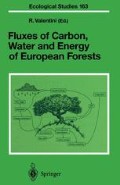Abstract
Natural forests with a high percentage of spruce will be found in Europe only in subalpine and alpine regions or in the boreal forests of Scandinavia and Russia. Nevertheless, spruce belongs to the most important European tree species. Due to its favorable architecture and rapid growth, management practices have led to widespread monospecific spruce forests in a latitude band between 45 and 55°N. Only recently have other species such as beech and oak been included in afforestation efforts at former pure spruce sites. So today spruce is still an important forestry tree in central Europe, with a coverage for instance of about 33 % of all forested areas in Germany (Bundesministerium für Ernährung, Landwirtschaft und Forsten 1999).
Access this chapter
Tax calculation will be finalised at checkout
Purchases are for personal use only
Preview
Unable to display preview. Download preview PDF.
References
Aubinet M, Grelle A, Ibrom A, Rannik Ü, Moncrieff J, Foken T, Kowalski AS, Martin PH, Berbigier P, Bernhofer C, Clement R, Elbers J, Granier A, Grünwald T, Morgenstern K, Pilegaard K, Rebmann C, Snijders W, Valentini R, Vesala T (2000) Estimates of the annual net carbon and water exchange of European forests: the EUROFLUX methodology. Adv Ecol Res 30:113–175
Bernhofer C, Feigenwinter C, Grünwald T, Vogt R (2002) Spectral correction of water and carbon flux for EC measurements at the Anchor Station Tharandt. Tharandter Klimaprotokolle (in press)
Bundesministerium für Ernährung; Landwirtschaft und Forsten (1999) Bericht über den Zustand des Waldes — Ergebnisse des forstlichen Umweltmonitoring. http://www.bml.de/wald_forst/waldzustandsbericht_1999/index.htm
De Bruin H AR, Verhoef A (1997) A new method to determine zero-plane displacement. Bound Layer Meteor 82:159–164
Falge E, Baldocchi D, Olson RJ, Anthoni P, Aubinet M, Bernhofer C, Burba G, Ceulemans R, Clement R, Dolman H, Granier A, Gross P, Grünwald T, Hollinger D, Jensen N-O, Katul G, Keronen P, Kowalski A, Ta Lai C, Law T, Meyers BE, Moncrieff J, Moors E, Munger JW, Pilegaard K, Rannik Ü, Rebmann C, Suyker A, Tenhunen J, Tu K, Verma S, Vesala T, Wilson K, Wofsy S (2001) Gap filling strategies for defensible annual sums of net ecosystem exchange. Agric For Meteorol 107:43–69
Grünwald T, Bernhofer C (1998) Data gap filling with regression modelling. Forest ecosystem modelling, upscaling and remote sensing. SPB Academic, The Hague, pp 61–67
Hager H (1975) Kohlendioxyd-Konzentrationen, -Flüsse und -Bilanzen. Münchner Universitätsschriften, Fachbereich Physik, Wissenschaftliche Mitteilung 26, University of Munich, Meteorologisches Institut
Jarvis PG, James GB, Landsberg JJ (1976) Coniferous forests. In: Monteith JL (ed) (1976) Vegetation and the atmosphere, vol 2. Academic Press, London, pp 171–240
Larcher W (1994) Ökophysiologie der Pflanzen, 5th edn. Ulmer, Stuttgart
Laubach J (1996) Charakterisierung des turbulenten Austausches von Wärme, Wasserdampf und Kohlendioxid über niedriger Vegetation anhand von Eddy-Korrelations-Messungen. Wissenschaftliche Mitteilungen aus dem Institut für Meteorologie der Universität Leipzig und dem Institut für Troposphärenforschung e.V. Leipzig, vol 3, 139 pp
Laubach J, Raschendorfer M, Kreilein H, Gravenhorst G (1994) Determination of heat and water vapour fluxes above a spruce forest by eddy correlation. Agric For Meteorol 71:373–401
Lee X (1998) On micrometeorological observations of surface-air exchange over tall vegetation. Agric Forest Meteor 91:39–49
Lloyd CR, Culf AD, Dolman AJ, Gash JH (1991) Estimates of sensible heat from observations of temperature fluctuations. Bound Layer Meteor 57:311–322
Martano P (2000) Estimation of surface roughness length and displacement height from single-level sonic anemometer data. J Appl Meteor 39:708–715
Mellmann P (1998) Die Bedeutung der Speicherterme bei zeitlich hochauflösender Verdunstungsbestimmung am Beispiel der Ankerstation Tharandter Wald. Diplomarbeit, Institut für Hydrologie und Meteorologie, TU Dresden
Monteith JL (ed) (1976) Vegetation and the atmosphere, vol 2. Case studies, Academic Press, London, 439 pp
Monteith JL, Unsworth M (1990) Principles of environmental physics. Arnold, London, 291 pp
Mund M, Kummetz E, Hein M, Bauer GA, Schulze E-D (2002) Growth and carbon stocks of a spruce forest chronosequence in central Europe. For Ecol Manage (submitted)
Oke TR (1987) Boundary layer climates, 2nd edn. Methuen, London, 435 pp
Rotach MW (1994) Determination of the zero plane displacement in an urban environment. Bound Layer Meteor 67:187–193
Valentini R, Matteucci G, Dolman AJ, Schulze E-D, Rebmann C, Moors EJ, Granier A, Gross P, Jensen NO, Pilegaard K, Lindroth A, Grelle A, Bernhofer C, Grünwald T, Aubinet M, Ceulemans R, Kowalski AS, Vesala T, Rannik Ü, Berbigier P, Lousteau D, Gudmundsson J, Thorgeirsson H, Ibrom A, Morgenstern K, Clement R, Moncrieff J, Montagnani L, Minerbi S, Jarvis PG (2000) Respiration as the main determinant of carbon balance in European forests. Nature 404:861–865
Vogt R (1995) Theorie, Technik und Analyse der experimentellen Flußbestimmung am Beispiel des Hartheimer Kiefernwaldes. Stratus 3, Abteilung für Meteorologie und Klimaökologie, MCR-Lab, Geogr Institut, University of Basel
Editor information
Editors and Affiliations
Rights and permissions
Copyright information
© 2003 Springer-Verlag Berlin Heidelberg
About this chapter
Cite this chapter
Bernhofer, C. et al. (2003). Spruce Forests (Norway and Sitka Spruce, Including Douglas Fir): Carbon and Water Fluxes and Balances, Ecological and Ecophysiological Determinants. In: Valentini, R. (eds) Fluxes of Carbon, Water and Energy of European Forests. Ecological Studies, vol 163. Springer, Berlin, Heidelberg. https://doi.org/10.1007/978-3-662-05171-9_6
Download citation
DOI: https://doi.org/10.1007/978-3-662-05171-9_6
Publisher Name: Springer, Berlin, Heidelberg
Print ISBN: 978-3-642-07848-4
Online ISBN: 978-3-662-05171-9
eBook Packages: Springer Book Archive

